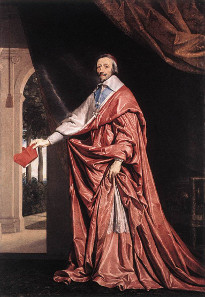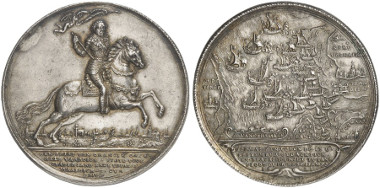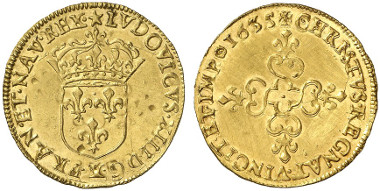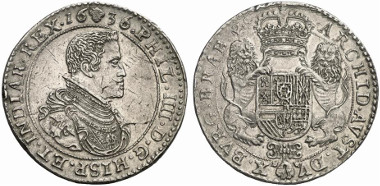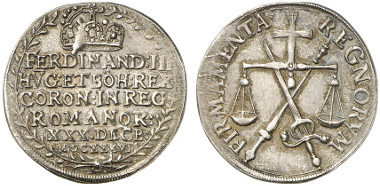translated by Annika Backe
The truce between the allies of Sweden in Germany and the emperor was followed up by the Peace of Prague whose terms were made public in Vienna on May 30, 1635.
Front page of the Peace of Prague from 1635. Source: Wikicommons.
Ferdinand hoped that his suggestion for an agreement would result in all moderate forces of his empire to commit to him again and become united in an encompassing peace treaty. His success bore him out – for the moment at least. The emperor managed to bring in the following important electors again: the prince electors of Brandenburg, the dukes of Saxe-Coburg, Holstein, Mecklenburg and Pomerania, the regent of Württemberg as well as the important cities of Lübeck, Frankfurt am Main, Ulm, Worms, Speyer and Heilbronn.
The German system of alliances collapsing at least made it easier for the Swedes to provide their troops with provisions. Consequently, the military commanders permitted their soldiers to replenish from the country free from restraints, without fearing that their allies might take reprisals.
In his portrait from about 1637, Philippe de Champaigne did not depict Richelieu sitting, as a clerical authority, but standing, as a secular prince. Source: Wikicommons.
The imperial power experiencing a Renaissance, Richelieu strengthened the armies of Habsburgs’ enemies on all fronts. In the Treaty of Compiègne, signed on April 30, 1635, Richelieu offered the Swedes 12,000 soldiers and half a million livres for the concession of the left bank of the Rhine from Breisach to Strasbourg.
The French in turn left the Swedes Worms, Mainz and Benfeld. The Swedes had to make sure that all Catholics in Germany could exercise their faith without hindrance. As a quid pro quo, France committed itself to not conclude peace with the Habsburgs without including the Swedes, and to openly declare war to Spain, which took place in Brussels on May 21, 1635. A herald solemnly announced that the French king was not inclined to sanction the injustice the archbishop of Trier had suffered by the Spanish king whilst under French protection.
Frederick Henry of Orange, Stadtholder of the Netherlands. Silver medal 1631 (by A. van der Wilge). On the naval battle on the Slaak of Volkerak against the Spanish. Auction sale Künker 247 (2014), 5377.
The declaration of war almost coincided with the French invading the Netherlands where they then defeated the Spanish military forces at Namur. The original plan had been to join the forces of Prince Frederick Henry of Orange near Maastricht, whose army, consisting of 30,000 men, was likewise funded by France. However, Frederick Henry hesitated to align himself with the French. The Prince of Orange was afraid that a powerful France might even make a claim to the Southern Netherlands.
Most of all, he was not interested anymore to inflict a crushing defeat on the cardinal-infante. Too big a defeat could have generated a power vacuum that France might have filled. Hence, things stayed as they were, for the time being. Although the juvenile stadtholder, who had obtained a couple of military victories, was quite popular in the Netherlands, he did not seem to pose a real threat. His own relatives at the Spanish court had neutralized him by sending a kind of ‘watchdog’ to Brussels who was to monitor his actions and prevent him from accumulating too much power.
Apart from the army that invaded the Netherlands, Richelieu funded a second one, which advanced against the Spanish in Northern Italy. Led by the former leader of the Huguenots, Rohan, the troops of this army managed to seize the Valtelline Valley, joining forces with the Protestant party of the canon of Grisons, under the command of Jürg Jenatsch whom Gottfried Keller erected a literary monument in one of his novels.
France. Louis XII. Ecu d’or au soleil, 1635 X, Amiens. Auction sale Künker 234 (2013), 3059.
Wealthy France started to become overburdened by funding both the troops of its allies and its own soldiers. In addition, the French armies turned out to be not as loyal and powerful as Richelieu had hoped. Many noble officers refused to comply with the commands of their superiors. Their professional pride did not allow them to subordinate themselves. Richelieu had to look for other options, then, to rout the Habsburgs. The most capable and most ambitious military commander was Bernhard of Saxe-Weimar. He was the nominal general-in-chief of both the Heilbronn League and the king of France. Richelieu tried to get him under French control completely.
In October 1635, he concluded a contract with him. Bernhard of Saxe-Weimar received 4,000,000 livres every year for his 6,000 cavalrymen and the 12,000 infantrymen plus a personal aid of 200,000 lives and an annual pension in the amount of 150,000 livres. Furthermore, Richelieu assured him of the County of Hagenau and the Landgraviate of Alsace if Bernhard complied with the commands from Paris for as long as the war against Habsburg would take.
Spain. Philip IV. Double dukaton, 1636, Brussels. Auction sale Künker 154 (2009), 1531.
While Richelieu spread himself too thin on the multiple fronts, Madrid came up with the idea of laying siege on Paris and hence force France to back out of the war. The cardinal-infante was to lead the army which Maximilian of Bavaria, as ally of Ferdinand II, had to provide. But the badly and halfheartedly prepared invasion of 1636 failed and the Bavarians were forced to withdraw from France – as were the French from the Valtelline, which they had conquered with quite an effort only the year before.
Even though the Habsburgs’ attempt to force the Bourbons to retreat from the war was unsuccessful, things did not look that bad for Ferdinand on an international level. With the Peace of Prague, he had won many princes over to his side and was interested in demonstrating this newly established unity. He called an imperial diet, to take place in Regensburg in autumn 1636. It was opened on September 15.
Holy Roman Empire. Ferdinand III. Silver off-metal strike from the dies of the double ducat 1636, on his coronation as Holy Roman Emperor in Regensburg. Auction sale Künker 237 (2013), 3143.
The most important item of the agenda was the election of the German King. Ferdinand witnessed his son, Archduke Ferdinand, victor at Nördlingen, being unanimously proclaimed King of Germany on December 22, 1636. That was just in time. On his return from the imperial diet, Ferdinand II fell ill. As a dying man he arrived in his hometown Vienna. A week later, on February 15, 1637, the emperor passed on.
Read in the next part how the fortunes of war turned completely.
All parts of the series can be found here.





